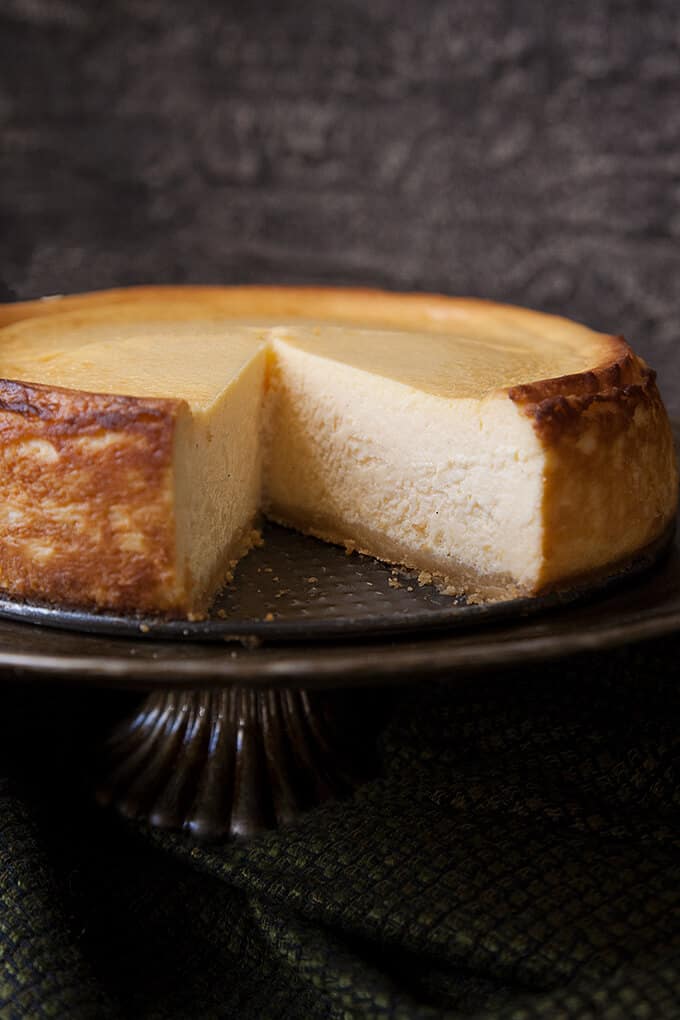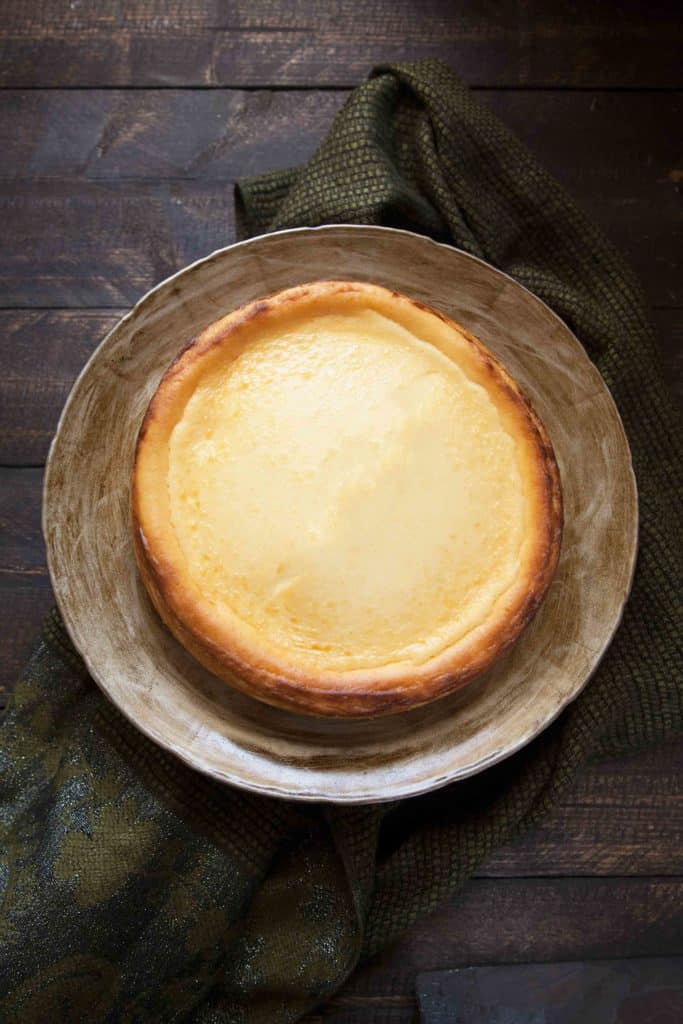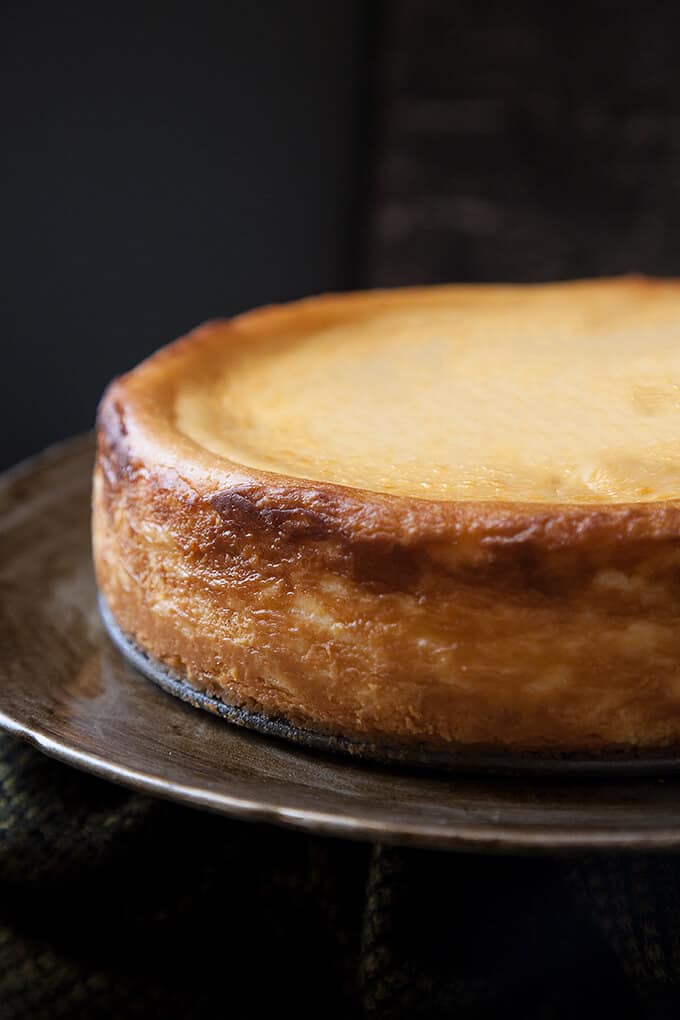Classic New York Cheesecake is a heavenly cloud of silky perfection. Rich, creamy, and ethereally light, this tall and proud cheesecake is crowned with stunning browned edges and sits atop a buttery, crunchy shortbread crust.
The quintessential Classic New York cheesecake ranks among Gotham’s most iconic foods. The proper New York cheesecake has a simple and unchanging list of ingredients: cream cheese, eggs, sugar, vanilla, and cream. The result is rich yet light, and the perfect balance of tart and sweet.
This Classic New York Cheesecake uses a full 2 ½ pounds of cream cheese. That's a whopping 5 packs! The result is a tall, gorgeous cake that is decadently rich and creamy. Shortbread cookie crumbs used in the crust don't get soggy and complement the flavor of the cheesecake perfectly without distracting from it.
I use two different methods for baking a Classic New York Cheesecake. Both are from Cook's Illustrated. This is the more traditional, yet riskier method. The cheesecake initially bakes for 10 minutes in a 500 degree F oven. This is what gives the gorgeous brown, puffy edges and golden top. Then the oven is turned to 200 degrees to finish baking for about an hour and a half. This slow bake at a low temperature gives the cheesecake a soft, silky texture and does away with the need for using a water bath.
The reason this method is risky is that different ovens will reduce their temperature from 500 degrees to 200 degrees at different rates. If your oven is very efficient at retaining heat, it will not cool to 200 degrees quickly enough, possibly not even before the cheesecake is finished. This can result in baking too quickly in a too hot oven, which can lead to cracks. (Or an enormous gash. Done that.) It is essential to use both an oven thermometer and an instant read thermometer when baking the cheesecake. My oven releases heat too slowly, so I open the oven door until the temperature reaches 200 degrees. I have found this to be the safest way of using this method. The most foolproof way of testing the cheesecake for doneness is by taking its temperature with an instant read thermometer. Cook's Illustrated says to take the cheesecake out of the oven at 150 degrees F. I've taken mine up to 158 degrees with beautiful results.
While I love the puffy brown edges and authentic look of the "risky" method, the "foolproof" method also gives very good, very reliable results. I'll share this method with you in an upcoming post. Stay tuned! 🙂
For the purist, Classic New York Cheesecake is most satisfying unadorned and unadulterated so that nothing distracts from the perfectly balanced flavors. If you prefer, a dollop of whipped cream or a spoonful of Roasted Cherries makes a perfect topping.
Jump to Section
Recipe

Classic New York Cheesecake
Ingredients
For the crust:
- 1 ½ cups shortbread cookie crumbs finely ground (6.75oz, 191g)
- 3 tablespoons butter melted (1.5oz, 43g)
For the filling:
- 2 ½ pounds full fat Philadelphia cream cheese room temperature (40oz, 1134g)
- 1 ½ cups granulated sugar 10.5oz, 298g
- ⅛ teaspoon salt
- ⅓ cup sour cream room temperature (2.5oz, 72g)
- 2 teaspoons lemon juice
- 2 teaspoons vanilla extract
- 6 large eggs room temperature
- 2 large egg yolks room temperature
Instructions
For the crust:
- Adjust oven rack to the lower-middle position and preheat oven to 325 degrees F.
- Mix the cookie crumbs and the melted butter until well combined and moistened.
- Press the crumbs into the bottom of a 9-inch springform pan. Using a flat bottomed measuring cup, press the crust firmly and evenly into the bottom of the pan,
- Bake on a lower-middle rack until golden brown around the edges and fragrant, about 10 minutes. Set aside to cool.
For the filling:
- Make sure the cream cheese, sour cream, and eggs are at room temperature for a silky smooth texture.
- Increase the oven to 500 degrees F.
- Using a stand mixer fitted with the paddle attachment, beat the cream cheese, salt, and one half of the sugar on medium-low speed for about 1 minute, until combined.
- Beat in remaining sugar and beat until combined, about 1 minute. Scrape the paddle and the bowl well.
- Add sour cream, lemon juice, and vanilla and beat at low speed until combined, about 1 minute. Scrape the paddle and the bowl well.
- Add egg yolks and beat until combined, about 1 minute. Scrape the paddle and the bowl well.
- Add whole eggs, two at a time, and beat for about 30 seconds after each addition, scraping the paddle and the bowl after each addition.
- Strain filling in a wire mesh strainer set over a bowl.
- Tap bowl on the counter several times so that any large air bubbles come up.
- Brush the sides of the springform pan with butter and place on a baking sheet. Pour the filling into the pan and set aside for 10 minutes, allowing any air bubbles to rise to the top. Pop any unpopped bubbles with a fork.
- Bake in a 500 degree F oven, checking with an oven thermometer, for 10 minutes.
- Reduce the temperature to 200 degrees F and continue to bake until the center of the cheesecake registers 150 degrees F on an instant-read thermometer, about 1 ½ hours.
- Keep an eye on the oven thermometer to be sure the temperature is dropping to 200 degrees F. If it doesn't drop, crack the oven door open until the 200 degrees is reached.
- Place the pan on a cooling rack for 5 minutes, then run a knife around the cake to loosen it from the edges of the pan. Allow to cool to room temperature, 2 ½-3 hours.
- Wrap tightly in plastic wrap and refrigerate until cold and firmly set, at least 6 hours.
To serve:
- Gently unmold cheesecake and remove the sides of the pan. Slide a thin metal spatula between the crust and pan bottom. Gently slide cheesecake onto a serving platter. If the bottom of your pan has a small lip around it, it may be easier to leave the pan bottom under the cheesecake and place it on the serving plate.
Notes
- This slow bake at a low temperature gives the cheesecake a soft, silky texture and does away with the need for using a water bath.
Nutrition
Recipe adapted from Cook's Illustrated The Science of Good Cooking.














Lew
What size mesh should be used for the screen? Can’t wait to try this out!
Kelly
Hi Lew! I use a smallish screen but not the very smallest. Just small enough to catch any lumps without waiting forever for it to go through.
Jana
Great description of how to regulate the temperature, my cheesecake came out pretty and without any cracks, although mine was lower because I made only half the quantity. It's also really delicious - but quite heavy - I ate a piece and a half and now I can't move. :-))
Kelly
So glad you liked it, Jana!
Colleen
Goodness, I love cheesecake and now I'm craving it so hard. That's an interesting method for getting that classic NY cheesecake look. I've only made a few cheesecakes, but I let them cool slowly at the end of baking to prevent the crack. That involves turning off the oven, cracking the door, and being patient. But make sure you're not distracted and playing out back with your son while it bakes... Made that mistake when I baked this Black Forest Cheesecake (https://www.bakesandblunders.com/decadent-black-forest-cheesecake/), but it still ended up being just fine. And if you dump homemade cherry pie filling on it, no one will see if there's a crack!
Kelly
Cherry pie filling on top works every time! Thanks so much, Colleen!
Julie
If you have a double oven, you can set one for 500 and the other at 200. After 10 minutes in the 500 degree oven, move the cake to the 200 degree oven.
Kelly
That would be the perfect option! Thanks, Julie!
Michael Parish
The key to doing the 500 degrees and down to 200 is to drop the temp after ten minutes, AND open the oven door to get rid of the high heat. Then close the oven door and bake for roughly the 1-1/2 until the 150 degree internal temp. It works perfectly every time. I've never had a crack using this recipe from American's Test Kitchen. Make sure you don't leave in your pizza stone which will retain heat even after opening the oven door. Since I've made this over a dozen times I now forget the internal temp(it saves from making a hole in my bake) and bake it for one hour and twenty minutes for my particular oven. Hope this helps someone do it to perfection.
Kelly
Thanks Michael! I always have to leave my oven door open til it drops to 200 degrees. My oven retains heat pretty well. It also takes away any uncertainty in knowing exactly how fast the oven is supposed to drop in temperature.
elaine martell
how long do you leave the door open?
Kelly
Hi Elaine, I open the oven door until the temperature reaches 200 degrees.
nita
Looks amazing with such great height! Your photos of the cheesecake are absolutely beautiful as well!
Kelly
Thanks, Nita!